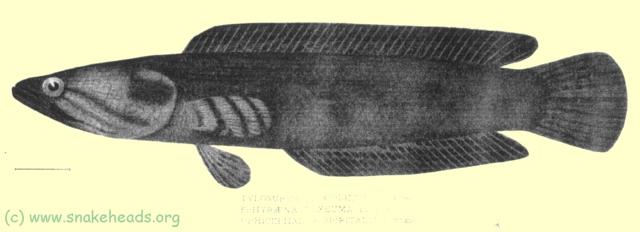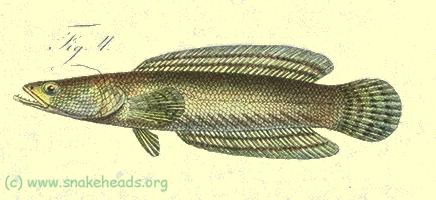
During the late summer and autumn of 1901 Mr. Alfred C. Harrison Jr. and Dr. H.M: Hiller formed an important zoological collection while pursuing their explorations in Sumatra. Most of the reports on the different groups have already appeared tin the Proceedings of the Academy, and as the fishes comprise a large part of the material they have demanded corresponding attention.
But two localities appear on the labels. With the exception of a few freshwater forms taken at Batu Sangkar, Tanah Datar, in Padangsche Bovenland at an elevation between 1500 and 3000 feet, the specimens were secured in the markets or environs of Padang. Many are food fishes, evidently of importance, though no particular information concerning the fisheries, local names, etc., has been preserved.
The collection was submitted to me for examination by Dr. Samuel G. Dixon, President of the Academy, to whom I am indebted for his opportunity of studying East Indian fishes. [...]
Difficulty, as usual, has been experienced in the identification of a number of species, owing to the short, incomplete or unsatisfactory accounts, with little relation or attention to geographical distribution. Many forms said to range throughout the Indian and Pacific Oceans should be examined and compared by means of abundance of material before such views acn be established as absolutely final. [...]
Head 3; depth 5 1/2; D. 39; A. 28; P. l. 16; V. l, 5; 55 scales to base of caudal in a lateral series; about 16 osseous scale before dorsal; 5 scales between origin of dorsal and lateral line, and 11 between latter and origin of ventral; widht of head 3 in its length; depth of head 2 7/16; snout 5 3/4; eye 7 1/4; mouth, from tip pof snaout, 3 1/2; maxillary 2 1/5; mandible 2 1/16; interorbital space 4 1/2; pectoral 2; ventral 2 5/6; caudal 1 3/4; least depth of caudal peduncle 2 1/4;
Body moderately elongate, rather thick, greatest depth about outer portion of ventral. Tail long, rather deep and compressed.
 | Plate IX. Fig.3: Ophicephalus spiritalis. Today it is considered to be a synonym of C. pleurophthalma. |
Head large, elongate, broad, depressed in front, and sides rounded with a swollen appearance. Snout short, broad, rounded when viewed above. Eye small, superior, and its posterior rim about first third in length of head. Mouth large, broad, oblique, and maxillary reaching below posterior portion of orbit. It is received in a deep infraorbital groove, and its distal extremity dilated till about three-fifths of eye-diameter. Mandible large, flattened below, and projecting well beyond tip of snout. Teeth in upper jaw minute, and in a broad band. Mandible with a small short patch of similar teeth at symphysis in front, and along sides a single series of enlarged, compressed, rather short and sharp pointed teeth. An outer series of small irregular pointed teeth along outer bases of enlarged teeth, in jaws. Vomer with a long fang in center, and several small teeth about. Palatines with a singles series of a few enlarged teeth, similar to those along sides of mandible. Tongue rather long, narrow and free. Lips rather broad and somewhat fleshy. Anterior nostril with a short bifid tube. Posterior rather large, circular, level with upper rim and nearly opposite front rim of orbit. Interorbital space broad and less flattened, becoming convex posteriorly.
Gill-opening large, extending forward till about an eye-diameter posterior to posterior rim of orbit, and branchiostegal membrance forming a broad fold over istmus. Gill-rakers small, short broad asperous stumps, and 7 in number of first arch. Gill-filaments short. Accessory branchial cavity large, and with a large fleshy valve.
Scales moderately large, cycloid, those on bases of caudal and pectoral fins small. On head above, and opercular region, scales become bony and firmly joined to top of head. Lateral line slightly oblique at fiest, then dropping down a scale over third anal ray and extending straight to base of caudal.
 | Ophicephalus polylepis. A drawing by Bleeker from his world famous atlas. O. polylepis is considered to be a synonym of C. lucia |
Color in arrack more or less brown, dark or dusky above, and lower surface withish or soiled brown. Trunk more or less mottles or blotched with blackish brown. A pale streak along side from opercle, and below this four or five large blackish blotches. Opercle with a blackish blotch. A dark streak from eye above obliquely across opercle, and another similar one from lower margin of eye. Fins all more or less dusky, with obliquely horizontal blackish lines on dorsal and anal in front, becoming more or less parallel with fin posteriorly. Caudal with indistinct blacking mottlings. Pectoral with four or five vertical cross-bars of blackish. Ventral mottled with dusky. Peritoneum silvery.
Length 11 1/5 inches.
Type No. 27,664, A.N.S.P. Padang.
One example. This species is close to Ophicephalus pleurophthalmus Bleeker differing however in color. Sides without the large ocelli of that species, but about six large brown blotches below lateral line, like those in Bleeker's figure of
 | Ophicephalus lucius. A drawing by Bleeker from his world famous atlas. |
(Spiritalis, belonging to air or breath. Applied as Ophicephalus is said to live in mud-pools and rise to the surface before it becomes sun-baked to take in air at times.)
This text was originally published in: Journal of the Academy of Natural Science Philadelphia . 1904 vol. 12. pp. 497-559. The drawings of Bleeker have originally been published in Atlas ichthyologique des Indes orientales néerlandaises; publ. sous les auspices du Gouvernement Colonial néerlandais par Pieter Bleeker Part VIII, table CCCXCVII, fig. 4, 1878. The publishing on snakeheads.org has been made possible with several very helpful and cooperatives ladies of the Staatsbibliothek Berlin . Thankyou dear ladies of the Stabi, thankyou institution Stabi!
| © 2001 - 2003 snakeheads.org | HOME of this page |